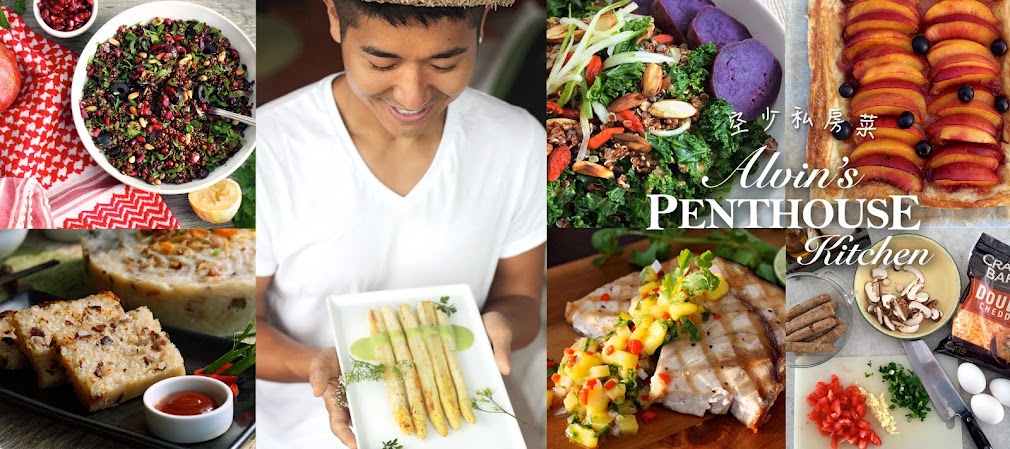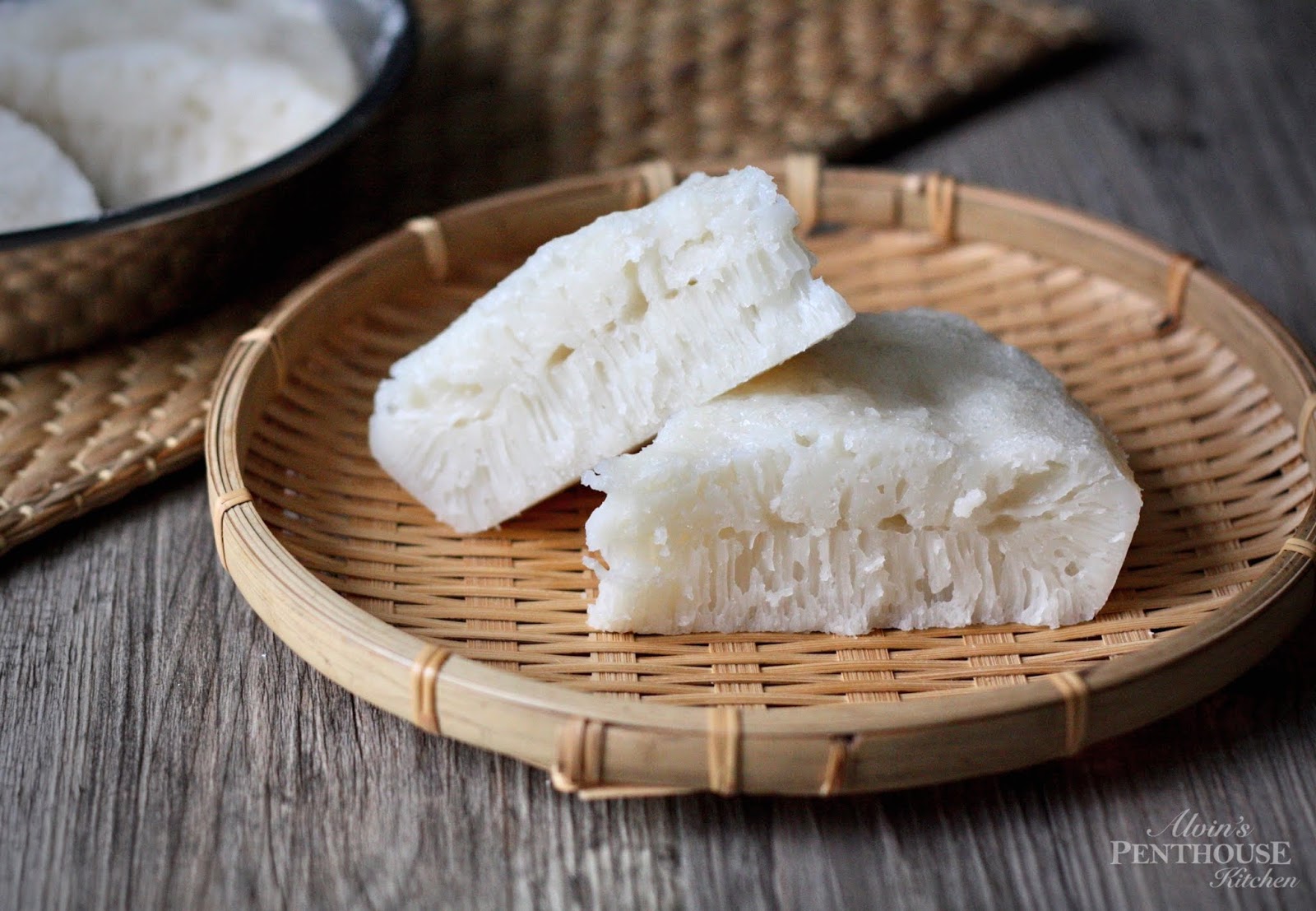 |
| 附中文食譜 |
The classic Chinese steamed white sugar sponge cake is a childhood favorite for many, and it is no exception for me growing up in 1990's Hong Kong. The sheer thought of this humble street snack brings back many sweet memories - of my mother always buying me a couple of slices every time she visited the wet market; and me always looking at her with puppy eyes whenever we passed by a shop selling the familiar triangular slices. It is a symbol of joy in its simplest form.
The steamed white sugar sponge cake (白糖糕,
bak tong gou) is light and fluffy, glossy and slightly sticky to the touch, and
moist and springy on the inside. It is sweet - but not tooth-achingly sweet, with a faint floral aroma that reminds of
sweet rice wine and fermented glutinous rice that I adore (even as a child) and later come to recognize as
yeast. Tearing into the cake would reveal an intricate
honeycomb-like columnar structure that I always, to this day, find absolutely fascinating.
I may have since then left home for the United States for school for a number of years and not had
bak tong gou for ages, but my affinity for this childhood favorite never weakened. Even upon my return to Hong Kong, I always made a stop at this old hawker who sold all kinds of traditional homemade confections from a little cart on Wellington Street, Central. This old hawker would have long gone by now. And with this old gentleman being quite possibly the very last hawker vending traditional sweets under the government's non-transferable itinerant hawker license,
bak tong gou and the like will now be only found at handfuls of
traditional bakeries, congee shops, and occasional dim sum lunches across town. The fond memories that many of us share of this childhood favorite, however, never fades.
Making the steamed white sugar sponge cake at home is really rather simple. With such a simple and inexpensive ingredient list, making this cake yourself and revisiting the memory lane might in fact be easier than finding this cake on the streets these days. As the name suggests,
bak tong gou calls for
granulated white sugar, giving the cake that pure white appearance that becomes slightly off-white only with the addition of yeast. Using brown sugar would create a sister version of the sponge cake, (黃糖糕)
wong tong gou, or as Hong Kongers call it -
steamed yellow sugar sponge cake. And like many traditional Chinese cakes, the sponge cake is steamed rather than baked.
 |
| The yeast gives the steamed sponge cake a distinct, honeycomb-like columnar texture and appearance |
I have tried different methods and measurements for making the
bak tong gou, and the one I share here by far trumps all others when it comes to effort and ease. Conventional approach will suggest cooking the rice flour mixture together with the sugar syrup over low heat on the stove top, which would require rigorous stirring and a greater attention span to prevent lumps from forming. I have also tried the double-boiler method which, while providing less direct heat, likewise requires continuous stirring. Instead, to make life and an already easy recipe a whole lot easier (who doesn't like the sound of that?), simply dissolve the sugar and yeast in warm water and add them to the rice flour mixture and give that a good stir, and the mixture is ready to rest.
 |
| Bak tong gou should taste sweet but not sour, which is a sign of over fermentation |
By doing this, not only will you save loads of time from having to wait impatiently for the mixture to cool down before adding the yeast (lest you kill the yeast), you also spare a whole lot of elbow grease and the risk of ending up with undesirable lumps in the batter. Boom, an easy recipe just made even easier.
After putting together the batter, it is to be simply left covered for hours to allow the yeast to do its thing. The exact amount of time varies with ambient temperature, ranging anywhere from three hours in summer up to seven in colder months. Following the below technique will significantly cut the idle time, regardless the season.
I have long been known to detest precise measurements in the kitchen, relying almost too wholeheartedly on "the senses" and cups and tablespoons and only reluctantly pulling my kitchen scale out when converting recipes into metric units when called for. Most recipes online for the steamed sponge cake come in metric unit. Fortunately, the steamed sponge cake is very forgiving to minor mathematical errors. Out of convenience, here I provide both measurements in cups as well as
grams or millimeters. From here on out, with this recipe
finally consolidated and added to my collection, I am rejoicing that my kitchen scale can rest in peace inside the cabinet whenever I make
bak tong gou. Perhaps I would be making this cake and walking down the memory lane more often from now on!
Ingredients...
1 cup
warm water, divided
1 cup
water
2 cups (280 g)
rice flour
3/4 cup (150 g)
white sugar, divided
2 teaspoons
active dry yeast
1/4 teaspoon
vegetable oil
Proofing the yeast & making the batter
1. Transfer 1/4 cup of the
warm water into a cup or bowl. The water should be around or just slightly higher than body temperature (roughly 100
°F/38
°C) and not hot to the touch. Tip in the
active dry yeast along with 1/2 teaspoon of the
sugar, stir well and let rest for 10 minutes or until foamy
.


2. In a large mixing bowl, combine the
rice flour and 1 cup of
water (room temperature). Stir until thick and smooth.
3. Add
sugar to the remaining 3/4 cup of
warm water and mix well until
sugar dissolves. Check that the syrup is close to body temperature and
not hot to the touch.

4. Add the
yeast mixture and
syrup to the
flour mixture and stir well to
combine. Cover with cling wrap and place inside a microwave or oven
along with
two cups of boiling water to generate heat. Close the door
and let the batter rest for 2 hours or until large
bubbles form on the surface of the batter. Refresh the boiling water to
speed up the process if needed.
Steaming the cake
1. Grease a 9-inch round cake pan generously with oil. Once the batter is ready, remove from the oven, stir well, and transfer batter to a large measuring cup. Add vegetable oil and stir to combine.

2. For a smoother cake surface, pour batter over a strainer into the cake pan and discard the foam. Steam over high heat, covered with the lid wrapped with a tea towel, for 25 minutes.
3. Turn the heat off and allow the cake to rest in the steamer for 10 minutes with the lid off. Remove cake from the steamer and let cool for another 10 minutes on the counter. Slice and enjoy fresh at its best!
Note: Cover and store at room temperature for up
to 24 hours. After that, refrigerate for up to 4 days. To reheat, steam gently.
Is Bak Tong Gou also your childhood favorite?
Share with me or leave a comment below! Tag #alvinspenthousekitchen.
Find me on Instagram @alvinckl and @alvin.penthousekitchen and follow my Facebook Fan Page!
【 傳統白糖糕 】
自細對白糖糕就有著一種情意結。想當年媽媽知道我最愛白糖糕,每次落街市都會買來給我吃;人大了,白糖糕依然充滿著童年回憶。別看白糖糕外表平凡,一件好的白糖糕雪白晶瑩、味道清甜芳香而不酸、入口爽滑而稍韌,難怪令人難以抗拒。自家製白糖糕十分簡單,經過屢次改良,終於研製出以下最簡易、最省時、零失敗的食譜跟大家分享、一起懷緬童年!
材料:
溫水* 240 毫升
清水 240 毫升
粘米粉 280 克
砂糖 150 克
即溶酵母 2 茶匙
菜油 1/4 茶匙
做法:
1. 先用 60 毫升溫水來開即溶酵母,加入半茶匙砂糖,拌勻備用約 10 分鐘。
2. 粘米粉及清水拌勻至輕微黏稠狀,備用。
3. 剩餘砂糖與溫水攪勻至完全溶解。
4. 將發好起泡的酵母和糖水加入粘米粉漿內拌勻。
5. 蓋上保鮮紙,連同 2 杯滾水放置在微波爐或焗爐裡面發酵 2 小時,直至粉漿出現大氣泡。滾水會製造蒸氣熱力,有助粉漿在受控的環境下迅速發酵。
6. 發酵好的粉漿加入菜油拌勻,隔篩(隔除過量氣泡,白糖糕表面會更加光滑)倒入已掃油的圓形不鏽鋼碟內,用大火蒸約25分鐘。
7. 熄火開蓋,待涼約 10 分鐘後把白糖糕取出再晾涼約 10 分鐘後切件即成!
備註:
1. *注意暖水溫度應接近或輕微高於體溫,不應燙手,不然會「殺死」酵母。
2. 家中如有蒸籠,可以用蒸籠去蒸,不然可以用毛巾包著煲蓋隔水蒸,有助防止倒汗水滴在糕面,影響製成品。
3. 正宗白糖糕其實不該帶有酸味,而酸味可能來自發酵過度。
Is Bak Tong Gou also your childhood favorite?
Share with me or leave a comment below! Tag #alvinspenthousekitchen.
Find me on Instagram @alvinckl and @alvin.penthousekitchen and follow my Facebook Fan Page!



 As banana bread has a relative high moisture content, you may find that it never quite crisps up as much as stale bread when making French toast. It gives us all the more reason to pair banana bread French toast with additional toppings that bestows just that extra va-va-voom it needs.
As banana bread has a relative high moisture content, you may find that it never quite crisps up as much as stale bread when making French toast. It gives us all the more reason to pair banana bread French toast with additional toppings that bestows just that extra va-va-voom it needs.




















































